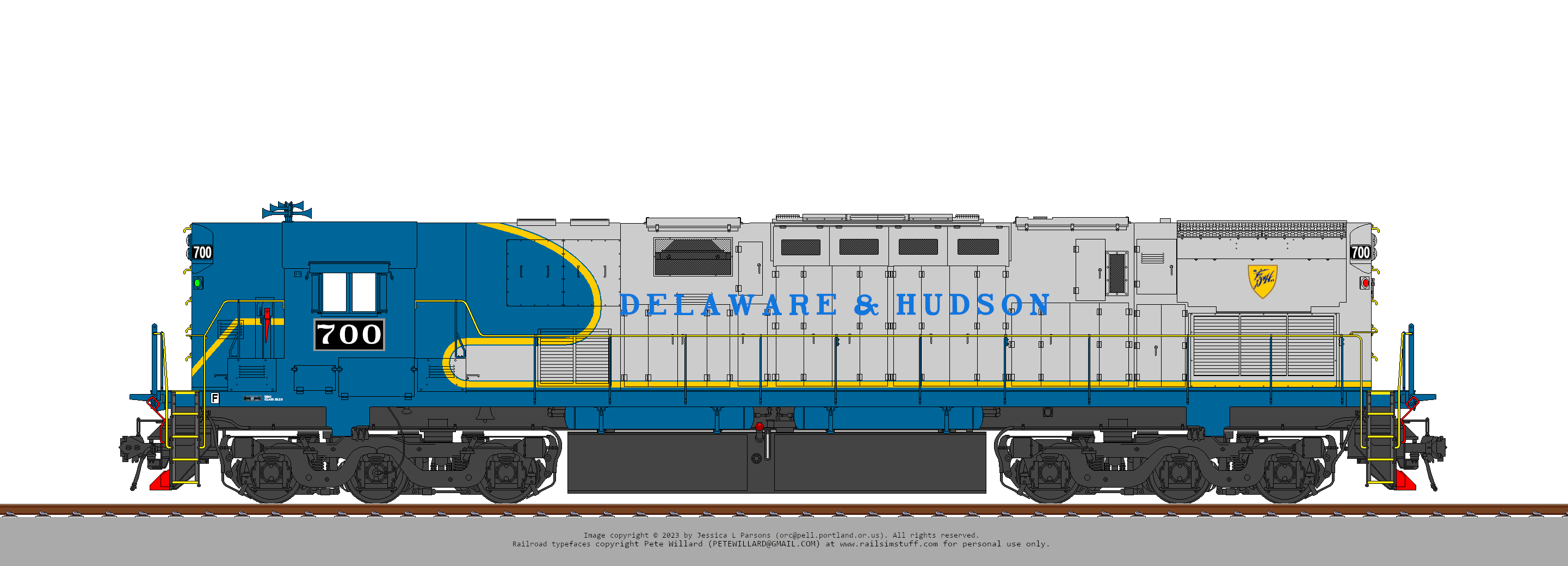The late 1970s/early 1980s were not good for the Delaware & Hudson, and by 1980 the railroad was on the verge of collapsing. The PV&T took notice when Guilford started proposing a bargain-basement takeover (less than a million US dollars!), and counteroffered, starting a small bidding war that ran the sale price up to US$20 million before Guilford threw in the towel.
One of the first things that the PV&T did with their new property was to buy the (now unused, but not torn down yet) overhead on Conrail’s Columbia & Port Deposit, purchase a handful of E44’s, and start operating electric freight from Harrisburg to Washington DC (followed soon thereafter by the purchase of the Atglen & Susquehanna Branch, and (after a fairly complex negotiation with Amtrak) trackage rights to Philadelphia over the Main Line and NE Corridor.
At the time of the takeover, the D&H had a huge collection of EMD and GE power to go along with their slowly dwindling Alco fleet. The D&H still, even 15 years after Alco was shut down, had an institutional preference for Alco power (tempered by the realization that their fleet was not getting younger and that nostalgia did not bring in the money they needed to survive), so the motive power departments of the PV&T (the TdM shops in St-Jean-sur-Richelieu) and the D&H found common ground in phasing out the EMDs (most of which lasted until the 1990s) and GEs (off the roster almost immediately) in favor of rolling all of the Alcos through the TdM shops for rebuilding as needed, as well as buying new ILW 251-equipped power and used Centuries to modernise.
The trackage right concessions that the D&H were given in the Conrail merger turned out to be a mixed bag; container freight from Baltimore, Philadelpha, and Newark turned out to be surprisingly profitable, but the transload facilities in Easton, Allentown, and Reading turned out to be worthless (leaving the old Alphabet Route as a very circuitous way to get to the coast.) From almost the day of the Parsons Vale’s takeover the D&H started planning for an alternate, which came together when the Lackawanna Cutoff and the Rahway Valley Railroad were purchased (and with trackage rights on NJ Transit and the newly formed Delaware-Lackawanna, this gave a route to Newark that was 50 miles shorter than the concession route.
The D&H kept the concession trackage rights to Newark until 2002, but the last freight on that track was in 1998; the trackage rights to Philadelphia had been surrendered three years earlier after running trains on the Main Line/Atglen & Susquehanna and NE Corridor had been debugged.
In 1992, the D&H purchased – with strings attached; a condition of the purchase was that Conrail would retain the monopoly on interchange to other Conrail lines between Owego & Niagara Falls – the Southern Tier, plus the Niagara & Lockport subdivisions (but not the industrial district that used to be the Niagara Junction).
The long-term plan for the D&H was to electrify the entire railroad, but this has been a long process. The line to Montréal was the first to go under wire (at 3000vdc, in 1988), followed by Albany to Sunbury (25kvac, in 1998), then Sunbury to Harrisburg (also 25kvac, in 2002), and finally the line west to Buffalo (completed in 2024).
In 2023, following passage of the USA’s Inflation Reduction Act, a government grant/loan was made to start electrifying (and increasing clearances to allow for double-stack under wire) the Southern Tier from Owego to Buffalo, which is expected to finish around the same time as the OSW’s CTRC electrification from Buffalo west, which, when it finished in 2025, resulted in the D&H being completely electrified.
In the late 2010s, the D&H started container train pools with the Union Pacific & BNSF, which, aside from greatly helping the bottom line, delighted west coast railfans when much of the D&H’s Alco fleet was assigned to the UP pool and an Alco emergency repair shop was built in Denver, CO.
The D&H owns or has part ownership in a variety of other railroads:
- Albany Port Railroad
- A terminal railway serving the Port of Albany. Jointly owned by the D&H and CSX.
- Allegany County Railroad
- ex-PS&N route between Ceres, NY & the Southern Tier at Swain
- Batavia Air Line
- Attica to Batavia, NY, with a branch connecting to the original Genesee & Wyoming in Retsof, NY.
- Columbia & Port Deposit
- Sunbury NY to Perryville MD. Jointly owned by the D&H and Norfolk Southern.
- East Penn & New Jersey
- Scranton to Newark (new trackage rights on the Delaware-Lackawanna & NJ Transit, plus the Lackawanna Cutoff & the Rahway Valley) plus a handful of (ex-Lucerne & Susquehanna branches in the Wyoming Valley.
- Napierville Junction
- The Canadian subsidiary that owns the D&H main from the Canadian border to Montréal, now jointly owned by the D&H and the TdM
- Ontario Southwestern
- Fort Erie, Ontario (across the river from Buffalo) to St Thomas, ON (formerly all the way to Windsor, but that was abandoned/spun off when the CTRC’s St Clair River tunnel was completed and all the international traffic moved away from the cramped and super-busy Michigan Central tunnel) along trackage that used to be NYC’s old Canada Southern & the Grand Trunk’s Fort Erie line, plus a handful of branch lines in the Golden Crescent. (Jointly owned by the D&H and the LT&L.)
- Owego & Harford
- Ex-LV trackage running north out of Owego. Purchased in 2020.
- Wellsboro & Corning
- A shortline running south out of Corning; it was purchased just as the fracking boom started, and now about 80% of its traffic is fracking sand.
- Saratoga & North Creek
- The D&H’s Adirondack Branch, which was spun off to become a tourist railway.
